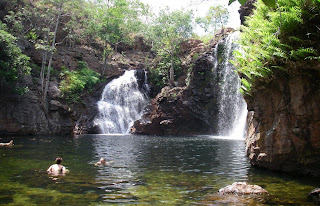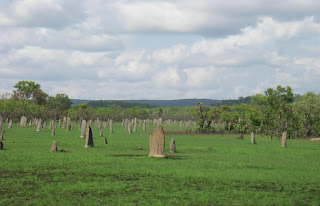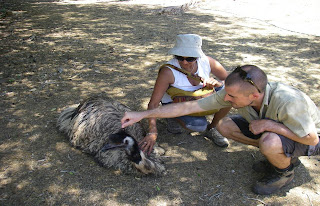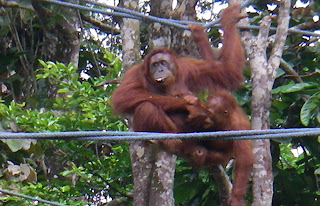The four day safari given the conditions was very tough and tiring considering the conditions we managed it and feel all the better for it. The group of people, two German couples, one French couple, Dutch girl and us got on very well and became friends at the end of the tour.
The water holes with clear water and the vegetation and the landscape surrounding it were very beautiful and great fun for swimmers.
 Lunch some where along the trail
Lunch some where along the trail Greenant falls-being brave here(water not too deep)
Greenant falls-being brave here(water not too deep)

 a series of water falls-Buley Rockhoe
a series of water falls-Buley Rockhoe
 along the trail
along the trail Florence falls- very steep
Florence falls- very steep crocks lurking in this area
crocks lurking in this area part of Litchfield national park
part of Litchfield national parkThe other major attraction in Litchfield Park are the many gigantic termite mounds. They are enormous in size. The mounds up to 2-3 meters in height are all constructed in one direction, a north to south position. This configuration acts as a kind of a temperature control mechanism so that the queen termite is not exposed to the heat of the sun. (All this information from our knowledgeable guide).

termite mounds everywhere quite a site

 one of the largest termite mound
one of the largest termite mound filling up on the water supply
filling up on the water supply part of the touring party
part of the touring party somehow not frightened of the emu
somehow not frightened of the emu emu taking a rest from the sun
emu taking a rest from the sun touring bus
touring busThe Nitmiluk Kathrine gorge can best be appreciated if one goes in a canoe to really see the scale and the sheer high cliffs of the gorge. The mid day sun and another day of 35 degree heat made that impossible and instead opted for a two hour cruise by boat.
Given time and good weather conditions one can walk along the trail above the gorge which wind's up and down through ever changing environment and landscape. May be 30 years ago would have been possible.

 two hour cruise is stunning
two hour cruise is stunning the gorge is huge and steep
the gorge is huge and steepLitchfield National Park , the next day was the favourite with thundering waterfalls, scenic water holes for swimming and forest treks with exotic bird life and various different reptiles. The young Australian tour guide very good and was very knowledgeable young chap who knew the region very well. This national park is also home to aboriginal people and the various shelters containing stone tools , grinding stones etc indicate that they have lived here for thousands of years.
Some of the water holes would have crocodiles in the wet season and in the dry season the water holes are surveyed and cleared of crocodiles before they are opened to the public. Some of us decided not to take any chances and not even dipped our toe in the water despite the guides assurances.

 wish i could remember all the names
wish i could remember all the names bird life in the park
bird life in the park small water fall with a large plunging pool
small water fall with a large plunging pool too deep for me
too deep for me one of the many water holes
one of the many water holes Ubirr escarpments
Ubirr escarpmentsDarwin & The Kakadu National Park.
When you arrive in Darwin , early in the morning the first thing you notice is the heat and sometimes the humidity that early in the morning. We thought Asia was hot but this heat after a while is unbearable.
The town is full of young people wanting to tour the "outback" so thought we would do the same and perhaps escape the heat of the city.
The hottest month is November, as our luck would have it, and is just before the onset of the rainy season and Darwin also happens to be one of the most lightning prone areas in the world so we thought we would escape from the area as soon as we can.
Decided that a camping safari would be an adventure and were promised fixed tent site with all the facilities and also got tempted by two for one offer. The national park is in the far N.E corner of the Northern territory and has a huge number of aboriginal rock site some of them over twenty thousand years old like the famous Nourlangie and Ubirr. These sites show the day to day living in the form of rock art paintings of fish , bird and mammals in an X ray style showing the bone structure. Unfortunately the aborigines now live in designated areas known as the reservations and suffer from various social problems, without much government assistance whilst their land is being exploited by big mining companies.
During the first day of the tour the heat (40 degrees) was unbearable and it was an open land with no shade except sometimes there was some shade along the sides of the mountains and the steep rocks. The area is full aboriginal cultural sites, towering escarpments which when you climb right to the top presents you with a 360 degree scenic views.
After a long hot day the whole touring party were very much looking forward to a good nights rest but when we saw the camp site in the middle of the bush and the tents were very small with just two single beds, the thought in every ones mind was when will we see the morning. The tents were so small and very hot, with no power or water supply and I had to check it very thoroughly to make sure there were no lizards or anything else lurking under the beds. The guide also turned out to be our cook and with the help of everyone produced a meal of Thai green curry and pastas washed with plenty of cheap Australian wine.
Bedtime was early at 9.00PM but 35 degrees in the tent and the sounds of animals and ruffling leaves, made any sleep impossible. Besides Rekha kept on hearing other noises and kept on asking me to check out to see if there was anything or anybody outside. No way was I going step outside the tent in pitch dark.I told Rekha to take it easy on the water and just prayed that she was not going to ask me to accompany her to the bathroom during the night which were about 50 meters away.
 similar tent but a different site
similar tent but a different site our sleeping quarters for the night
our sleeping quarters for the night near the aboriginal burial site
near the aboriginal burial site a view after a long walk in the heat
a view after a long walk in the heat real time views look great
real time views look great a view from the escarpment
a view from the escarpment flashfloods too dangerous to cross
flashfloods too dangerous to cross ignore one of them
ignore one of themThe boat trip in the Mary river to see the crocodiles was not as productive as we had hoped. Saw very few crocodiles as it was to hot for them to come out and sun themselves on the banks. The ideal temperature for them is 30-33 degrees. Apparently there are 5000 crocodiles in that stretch of water but as luck would have it we saw 7 to 8 of them. The monsoon forest in the river was intersting where the whole river is covered with water lilys with bright colour flowers and they were stretched in the river as far as one could see.






















